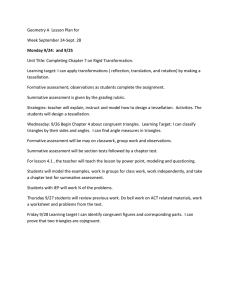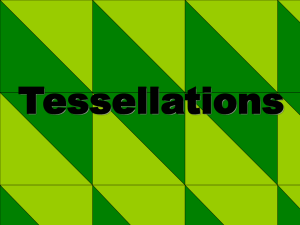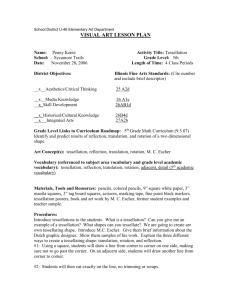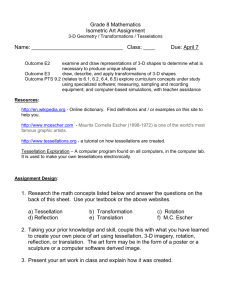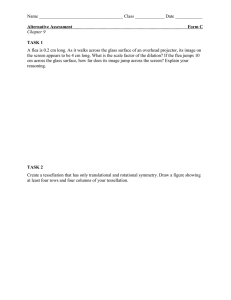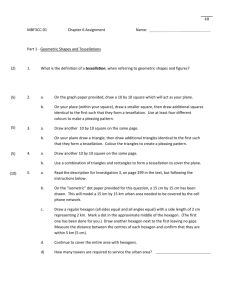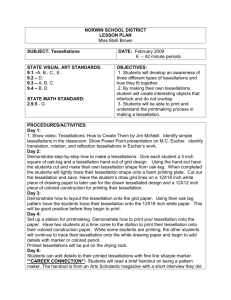Lesson Plan
advertisement
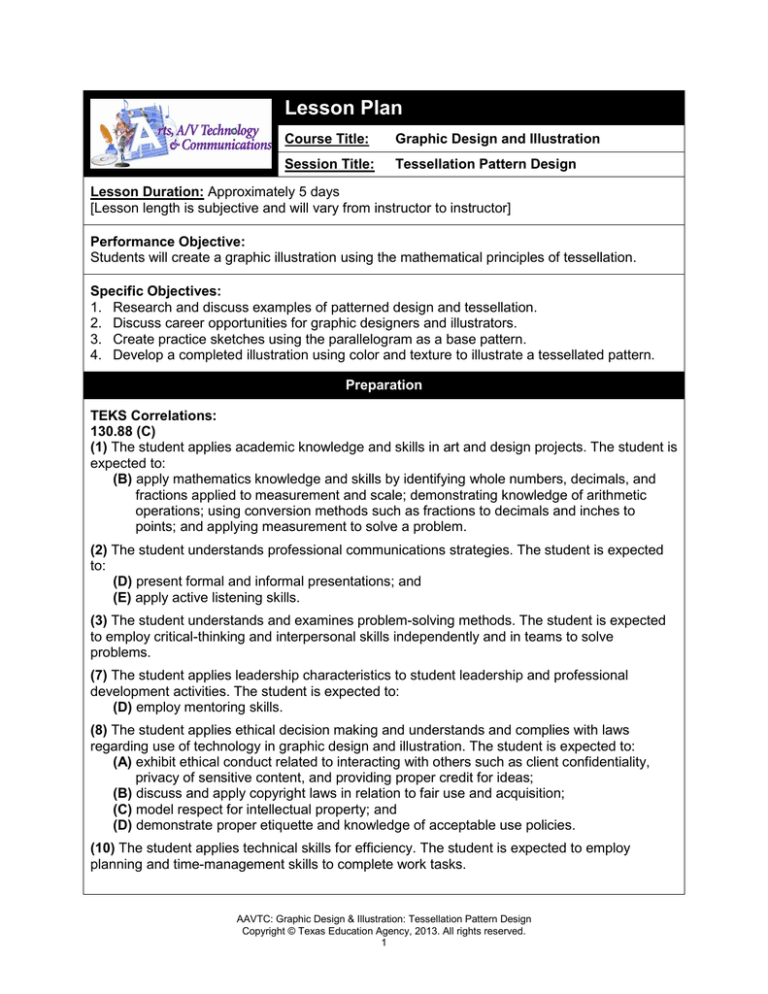
Lesson Plan Course Title: Graphic Design and Illustration Session Title: Tessellation Pattern Design Lesson Duration: Approximately 5 days [Lesson length is subjective and will vary from instructor to instructor] Performance Objective: Students will create a graphic illustration using the mathematical principles of tessellation. Specific Objectives: 1. Research and discuss examples of patterned design and tessellation. 2. Discuss career opportunities for graphic designers and illustrators. 3. Create practice sketches using the parallelogram as a base pattern. 4. Develop a completed illustration using color and texture to illustrate a tessellated pattern. Preparation TEKS Correlations: 130.88 (C) (1) The student applies academic knowledge and skills in art and design projects. The student is expected to: (B) apply mathematics knowledge and skills by identifying whole numbers, decimals, and fractions applied to measurement and scale; demonstrating knowledge of arithmetic operations; using conversion methods such as fractions to decimals and inches to points; and applying measurement to solve a problem. (2) The student understands professional communications strategies. The student is expected to: (D) present formal and informal presentations; and (E) apply active listening skills. (3) The student understands and examines problem-solving methods. The student is expected to employ critical-thinking and interpersonal skills independently and in teams to solve problems. (7) The student applies leadership characteristics to student leadership and professional development activities. The student is expected to: (D) employ mentoring skills. (8) The student applies ethical decision making and understands and complies with laws regarding use of technology in graphic design and illustration. The student is expected to: (A) exhibit ethical conduct related to interacting with others such as client confidentiality, privacy of sensitive content, and providing proper credit for ideas; (B) discuss and apply copyright laws in relation to fair use and acquisition; (C) model respect for intellectual property; and (D) demonstrate proper etiquette and knowledge of acceptable use policies. (10) The student applies technical skills for efficiency. The student is expected to employ planning and time-management skills to complete work tasks. AAVTC: Graphic Design & Illustration: Tessellation Pattern Design Copyright © Texas Education Agency, 2013. All rights reserved. 1 (11) The student develops an increasing understanding of graphic design and illustration. The student is expected to: (A) research art and design career opportunities and qualifications; (C) interpret, evaluate, and justify design decisions; (D) conduct oral or written critiques of designs by: (i) applying a critical method of evaluation; (E) analyze and apply art elements and principles; and (F) employ a creative design process to create original two- or three-dimensional projects by: (i) creating designs for defined applications; (ii) applying elements of design; (iv) using good composition; and (vii) creating a project by applying color. Interdisciplinary Correlations Art, Level I: 117.52(C) (1) Perception. The student develops and organizes ideas from the environment. The student is expected to: (A) illustrate ideas for artworks from direct observation, experiences, and imagination and (B) compare and contrast the use of art elements (color, texture, form, line, space, value) and art principles (emphasis, pattern, rhythm, balance, proportion, unity) in personal artworks and those of others, using vocabulary accurately. (2) Creative expression/performance. The student expresses ideas through original artworks, using a variety of media with appropriate skill. The student is expected to: (A) create visual solutions by elaborating on direct observation, experiences, and imagination; and (C) demonstrate effective use of art media and tools in design, drawing, painting, printmaking, and sculpture. (3) Historical/cultural heritage. The student demonstrates an understanding of art history and culture as records of human achievement. The student is expected to: (A) compare and contrast historical and contemporary styles, identifying general themes and trends; (B) describe general characteristics in artworks from a variety of cultures; and (C) compare and contrast career and avocational opportunities in art. Instructor/Trainer References: http://www.tessellations.org Instructional Aids: Tessellation Pattern Design slide presentation Tessellation Pattern Design Parallelogram Pattern template Tessellation Pattern Design Rubric Materials Needed: Sketch pads Drawing paper Rulers, pencils, colored pencils or markers AAVTC: Graphic Design & Illustration: Tessellation Pattern Design Copyright © Texas Education Agency, 2013. All rights reserved. 2 Equipment Needed: Computer and projection system with appropriate software to display slide presentation Computer with appropriate industry-standard photo editing and illustration software installed Computer with internet access Learner Needs some very basic understanding of geometry Introduction MI Introduction (LSI Quadrant I): ASK: Does anyone know what a Tessellation is? [start slide presentation] SAY: Graphic designers and illustrators are employed for a variety of tasks that incorporate the use of tessellations. Specialty printers are used to produce greeting cards, gift wrap, and other patterned papers. The textile industry employs designers for printed and woven fabrics. ASK: Can you think of other examples of patterned design? Outline MI Outline (LSI Quadrant II): Instructor Notes: I. Discuss career opportunities for graphic designers and illustrators. A. Discuss Escher’s role in tessellation B. View some of his tessellation art online (link in slide presentation) NOTE: Bring in some examples of wallpaper, greeting cards, textiles, etc. Brainstorm career opportunities. II. Create practice sketches using the parallelogram pattern. A. Draw a curved or geometric line beginning at one corner and moving in a clockwise direction making sure the line meets each corner. B. Consider the shape. If you see an object in the shape, develop it further. C. Try again to see what shapes emerge. D. The negative space will also need to be developed into an object. NOTE: This is a practice exercise to make sure that students understand the principle of Tessellation. Encourage collaboration. Some students may be able to point out objects that others do not see. This process is somewhat like finding shapes in clouds. The teacher will illustrate the method of using the parallelogram pattern template while the students work independently. AAVTC: Graphic Design & Illustration: Tessellation Pattern Design Copyright © Texas Education Agency, 2013. All rights reserved. 3 Application MI Guided Practice (LSI Quadrant III): The instructor will present the slide presentation on Tessellation Pattern Design to the students, and provide visual examples for better understanding. The instructor will monitor individuals as they create their practice sketches. The teacher will also demonstrate the technique of using the parallelogram pattern template while students observe. The teacher will post examples, objectives, and rubrics with the specifics for the final artwork. MI Independent Practice (LSI Quadrant III): Students will conduct research, develop ideas, and create artwork independently. Students will enhance their tessellation pattern design with color and texture to complete their illustration project. Summary MI Review (LSI Quadrants I and IV): Review the concepts of pattern design and research the role of M.C. Escher in Tessellation art. Evaluation MI Informal Assessment (LSI Quadrant III): Teacher will circulate during Guided and Independent Practice checking for understanding of concepts and techniques. Teacher will observe student progress and make suggestions/provide guidance as necessary. MI Formal Assessment (LSI Quadrant III, IV): Students will participate in a formal class critique using the criteria outlined on the Tessellation Pattern Design Rubric. The completed Tessellation illustration projects will be evaluated by the instructor using the Tessellation Pattern Design Rubric. Extension MI Extension/Enrichment (LSI Quadrant IV): Instead of a parallelogram, try a more challenging hexagonal or rotated tessellation. Encourage students whose work is exceptional to add it to their portfolio and publish/share it in a public forum such as: http://www.tessellations.org/essaystessellation-ratings.shtml AAVTC: Graphic Design & Illustration: Tessellation Pattern Design Copyright © Texas Education Agency, 2013. All rights reserved. 4 Tessellation Pattern Design Parallelogram Pattern AAVTC: Graphic Design & Illustration: Tessellation Pattern Design Copyright © Texas Education Agency, 2013. All rights reserved. 5 TESSELLATION PATTERN DESIGN RUBRIC Criteria Discussion Participation (10 points) Tessellation Project Criteria (30 points) Understanding of Tessellation (30 points) Creativity (20 points) Professional Appearance & Presentation (10 points) Comments: Exceptional Above Average Below Average Unacceptable 9-10 points 5-8 points 1-4 points 0 points Contributes to the discussion, adds new points of consideration. Contributes to the discussion. Some participation in discussion. Not engaged in discussion. 25-30 points 12-24 points 1-11 points 0 points Uses color and texture to enhance an interesting, well designed project. Creates an interesting, well designed project. Project has color and/or texture but it is not well designed. Project has no color and is oversimplified. 25-30 points 12-24 points 1-11 points 0 points Completes tessellation with clarity; pattern is seamless. Completes tessellation; pattern is seamless. Completes tessellation; pattern is not seamless. Does not complete tessellation. 17-20 points 8-16 points 1-7 points 0 points Design ideas are original in thought and exceptionally creative. Design ideas are somewhat original and creative. Limited evidence of creativity and originality in thought. No evidence of creativity or originality in thought or execution of project. 9-10 points 5-8 points 1-4 points 0 points Professional project. Final product is neat and professionally presented. Good presentation of project. Only minor corrections are needed Fair presentation of project. Several errors are evident. Project is unprofessional. Errors distract significantly from the content. TOTAL POINTS: AAVTC: Graphic Design & Illustration: Tessellation Pattern Design Copyright © Texas Education Agency, 2013. All rights reserved. 6 Points

